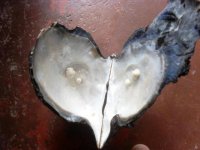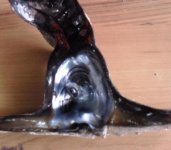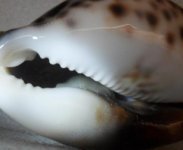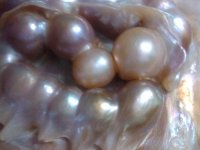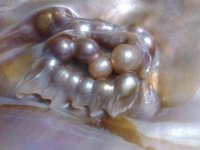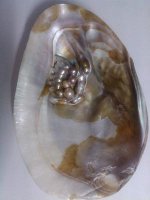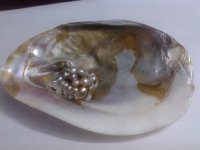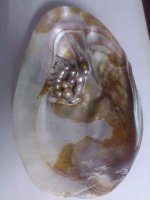Nevertheless, it seems to me that it is a piece of mere collection & I should retain it rather than to fetch a little price. Still I would like to know more about it.
The earliest known successful commercial freshwater operations took place in Japan in Lake Kasumiguara using the Biwa Pearl Mussel (Hyriopsis schlegeli). Pollution and elevated mean annual temperatures have caused most of the farms in that country to cease operation. For many years, China performed freshwater operations using the Cockscomb Pearl Mussel (Cristaria plicata). This species produced most of what we have come to know as rice crispy pearls. More than a decade ago, China developed a hybrid variation of a combination of Hyriopsis sp. (schlegeli and cummingi). Hybrids are preferred because of their heterosis, which means "evolutionary fitness". This is not to be confused with "genetic superiority", because while their growth and size are accelerated, natural fertility is minimal (if not non-existent), otherwise the environment would be choked out by natural recruitment.
There is a huge difference in the grafting techniques between fresh and sea water. Marine mollusks require a highly specialized grafting process (intragonadal) which is most often proprietary. On the other hand, freshwater mussels are grafted by entry level technicians, although expertise can increase volumes. Freshwater mussels don't have gonads as a singular organ, instead sharing the same space as the mantle skirt in a series of gonoducts leading from the heart. Given the high volume of multiple grafts in each piece, perforation of the mantle skirt is a common occurrence. It can either be caused by oversized incisions by the grafter or the pearl sacs may burst over time as the pearls grow. This causes the pearls to become lodged in the extrapallial space (between the shell and the mantle skirt).
The shell and blisters posted here, are certainly a Chinese hybrid. The "pinto" effect on the nacreous lining also suggests this. This shell has been worked, removing the peristracum, which a proteinaceous layer on the outside of the shell. As Blaire (Gem Geek) alluded, this is a minor value add to a by-product. It gives each piece some value, but certainly not premium or rare by any means.
Natural blisters have a greater value. Daniel (dmj) has done well to add value to his pieces by sourcing them directly from harvesters and adding flair in craftsmanship. Unlike loose pearls which can be measured in carats, blistered shells have no pricing or grading guidelines. Each piece stands on it's own as to size, appearance or quality. Over the years, we've seen some nice pieces done with blisters, whether jewelry, folk art or wall hangings.
